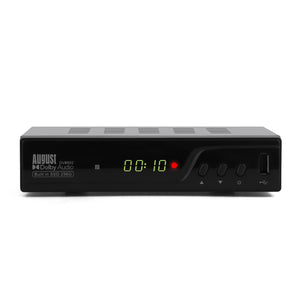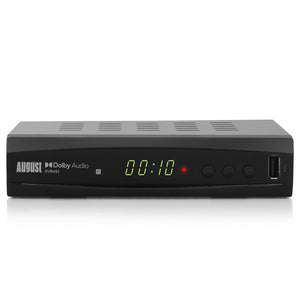Entering 2025, Freeview is now officially under a decade from being dismantled. No extension has been made to the 2034 deadline for Freeview, and the increased availability (albeit still quite low) of internet-based alternative "Freely" could mean we see the end of Freeview in just 9 years' time.
We need to make the most of Freeview, grasp what it is we are losing should it be shut down, and put into perspective just what an incredible service it is while we still can.
What is Freeview?
Freeview is the UK-based Free-to-Air TV service which uses DVB-T and DVB-T2 broadcasts. Other countries also use DVB-T and DVB-T2, but Freeview is the UK version.
The Freeview EPG and channels, as well as those updates we publish every month, are actually the responsibility of a larger group called Everyone TV. Everyone TV looks after Freeview, Freesat and, now, Freely.
In terms of Free-to-Access broadcasts, Everyone TV is the de facto solution in the UK.
There's more to them than just the modern maintenance of these systems, however, as under their previous name "Digital UK" they spearheaded the "Digital Switchover" from Analogue in the early 2000's.
Over the last 20 years Everyone TV have been responsible, in some shape or form, for over 1 Billion hours of free entertainment, art, shopping and news.
How to Get Freeview
Ever since it's inception, access to Freeview has been based simply on receiving it. All you need is a DVB-T aerial and a decoder to read the data (And, of course, a screen to watch on!).
There's no account set up or subscription to receive the channels, and while there are some Pay-Per-View channels on the EPG they are few and far between, actually hosted by different providers and put on the EPG for exposure and simplicity.
This all remains true in 2025. To watch Freeview in the UK you need:
- • 1 Digital Aerial. Either your rooftop aerial or a portable one, so long as it's for DVB-T and DVB-T2 signals you're set!
- • 1 Tuner / Decoder. This could be a TV with a built in tuner, which the aerial plugs right in to. Alternatively it could be a separate unit like a set top box or USB tuner, which can add other features before the signal hits your screen such as channel recording.
- • 1 Screen. If your tuner is built in to the TV this solves itself, but otherwise you'll need to get a TV, monitor or even a projector and hook it up the set top box.
Plug it all in, scan for channels, and you're done!
The main thing is these are all one-time costs. It's an investment to get the box and a good aerial and a nice screen, but then you're going to be able to access any Freeview TV you like from over 100 channels until 2034, another 9 years!
In that time you would have spent (Assuming prices don't go up, which is a bold assumption):
- • £540 on Netflix
- • £855 on Amazon Prime Video
- • £540 on Disney Plus
How Many Channels Are On Freeview?
The official Freeview website has a handy postcode checker tool which can give you an estimation of which channels are available and how strong their signal is, based on the nearest Freeview relay tower.
For most users in the UK this will be in excess of 100 channels. The office I'm sat in in Hoddesdon right now is reading 131 channels available, with 1 unavailable because it's delivered by IP (Internet Protocol) and 7 of them being HD versions of other channels.
You can also check for outages here, so it's worth having the link to hand.
Do You Need an Aerial for Freeview?
As outlined above, you will need a DVB-T / DVB-T2 compatible aerial to watch Freeview. This is true whether you watch through a TV, set top box or USB tuner for your computer. They'll all need an aerial.
There are ways to access Freeview without a rooftop aerial port in your home, but not without an aerial entirely.
What About Freely?
What you might be after is Freely, which (kind of) doesn't need an aerial (ish).
Freely uses internet connection to broadcast channels, but the vast majority still operate through an aerial. This means that even on a Freely system, you'll still want an aerial connected.
One day we might see a "Switchover" like we did from Analogue, and there's even some reasons to be excited for that (For example, enforcing and standardised minimum quality and cost of internet supply), but likewise there are reasons we shouldn't be hurrying to put all our eggs in one internet basket.
By 2034, I have to assume the aerial requirement will be more lax, and much more content will be available internet-only. Not to mention, I would hope by then that Freely have allowed manufacturers to make Freely Set Top Boxes and Freely USB Sticks, just like Freeview do already.
You can read all about how to get Freely here, notice how currently it's restricted to specific TVs unlike Freeview.
Freeview Changes in 2024
As we leave 2024, looking back there's certainly a case that the writing is on the wall. We have seen Everyone TV really push for Freely to be as large a network as possible, but we still don't have a stick or box solution. So, it's a mixed bag of Freely and Freeview fighting for accessibility and content.
Growth of Freely
The list of compatible TVs has expanded from 7 TVs of one brand to 40+ of over 5 brands. Similarly, the Freely EPG itself grew to include not only the core supporter of the BBC, but also ITV, Channel 4 and Channel 5 and even (most recently) AMC networks like PBS America and QVC.
Ultimately, Freely is still "playing catch-up" to Freeview, but it might not be long before Freely catches up, and then surpasses, the latter.
Decline of Freeview
While all these Freely developments were going on, we simultaneously saw decreased investment in Freeview, particularly from Radio companies.
For example, we lost Bauer stations: Greatest Hits Radio, Hits Radio, Kerrang! Radio, KISS Fresh, KISSTORY, Magic Radio and Absolute Radio from the Freeview Radio guide this year.
Those of you who have been keeping up with the Freeview Updates we run at Daffodil will have noticed many new channels added to Freeview, which could imply a strong sense of maintaining the system.
However, these new channels sometimes only last 2-3 months, and are replaced by another new channel shortly after. This rotation of channels is making the Freeview EPG inefficient to operate, with a focus on the core EPG channels paying off far better than any new, experimental or international offerings.
Public Mindset Towards Content
Finally, we have seen how streaming services have impacted the TV market, right down to the cost of the hardware itself. The streaming age has boosted the popularity of on-demand TV compared to broadcasts, but interestingly this has, in 2024, seen some resistance as studies cite enhanced retention, engagement and user interaction when shows are released episodically rather than dropped online all at once.
Freeview Still Going Strong
Overall, 2024 held a lot of momentum for Freely, and not so much for Freeview. Freeview is far from "dead" though, and the core EPG is still the strongest out there (Especially as Freely still recommends you have an aerial anyway).
These changes are by no means the last stand of Freeview, but simply indicate a shift in tone from development to maintenance.
Over the years before 2034 there are several new developments to be incorporated into DVB broadcasting, which may help convince the government to extend the deadline.
What's Next for TV Broadcasting?
We've seen how Freeview are pivoting to Freely, and how TV streaming in general has completely changed the way we consume content, even on TV.
However, standard TV broadcasting has some tricks up its sleeve to ensure it remains competitive. In the publication DVB Project, we have seen news that initiatives are running to have personalised ads via DVB-T, as well as customisable shows with different content warnings, audio mixes, camera angles and more.
Broadcasters are acutely aware of the hunger for instant, personalised content that speaks directly to the audience member, and are rushing to satiate that audience before the 2034 Freeview deadline in order to prove the long-term worth of DVB-T and DVB-T2.






I love freeview Especially Talking Pictures tv & Rewind.